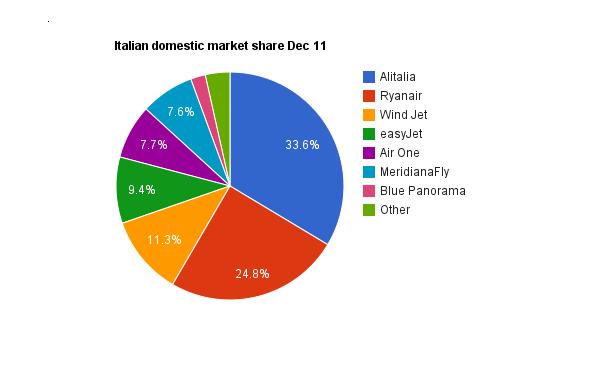Alitalia's planned acquisition of local carriers Wind Jet and Blue Panorama, together with Meridiana Fly's previously announced merger with Air Italy, caps a period of consolidation in the country's sector which all but leaves three main Italian scheduled operators.
Mergers, financial collapses and growing competition from low-cost carriers, notably EasyJet and Ryanair, has seen the number of Italian airlines gradually shrink from around 20 at the turn of the decade.
Alitalia had already soaked up the assets of Volare and Gandalf Airlines prior to its own revamp into private hands through a merger with Air One. The acquisition of Wind Jet and Blue Panorama - together with its Blu Express budget brand - will further supplement this group.
Meridiana Fly meanwhile, having merged with former Alitalia charter unit Eurofly - is now in the process of merging with Air Italy.
But following a decade which has seen names such National Jet Italia, Gandalf and Alpi Eagles come and go, this leaves Lufthansa unit Air Dolomiti as the only other sizeable player in the Italian scheduled passenger market. Some small niche carriers, such as Air Vallee and BelleAir Europe remain, while there is also Italian charter operator Neos.
"This is the story of deregulation," says David Jarach, air transport marketing professor at Milan's SDA Bocconi School of Management, and managing partner at consultancy Diciottofebbraio. "There were low barriers to entry and a lot of new entrants with limited critical mass and resources. At the same time you had high barriers to exit with some support from public and regional bodies.
"But as we are seeing all across Europe at the moment, 2012 is probably the cornerstone of rationalisation in the industry," Jarach says.
For Alitalia the acquisition of Wind Jet and Blue Panorama helps strengthen it market position and give critical mass to its Air One operation. Alitalia has positioned the Air One brand as a hybrid carrier aimed at countering the continued eating away of domestic market share by EasyJet and Ryanair - both of whom have profited from the difficulties facing Italian airlines.
 |
|---|
Source: Innovata |
"It gives them critical mass to deal with Ryanair and EasyJet on domestic routes," says Jarach. "Air One enjoys a better cost position [within Alitalia] but to really grow in the domestic market you need more critical mass, and they had only 10-12 aircraft."
Alitalia chief executive Rocco Sabelli has indicated most of the group's growth this year will be through Air One and it has already announced plans for a new base in Venice to add to its Milan and Pisa bases. "But to operate like this you really need the aircraft and the capacity," says Jarach. "With these operators they can grow their critical mass in the low-cost business."
Catania-based Wind Jet will bolster its presence on north-south routings, the key market in the increasingly low-yield Italian domestic market after high-speed rail links ate into lucrative domestic business routes. "It is a low-yield market," says Jarach. "The Italian domestic market is basically north-south destinations, which is mostly leisure and VFR traffic, with some small business traffic."
ITALIAN SCHEDULED AIRLINES OPERATING IN 2001 |
|---|
- Air Dolomiti
- Air Europe
- Air One
- Air Sicilia
- Air Vallee
- Alitalia
- Alpi Eagles
- AZZURAir
- Blue Panorama Airlines
- Eurofly
- Gandalf Airlines
- Italair
- Italy First
- Lauda Air Italia
- Med Airlines
- Meridiana
- Minerva
- National Jet Italia
- Volare
ITALIAN SCHEDULED AIRLINES OPERATING TODAY |
|---|
- Air Dolomiti
- Alitalia/Air One
- Air Italy (merging with Meridana Fly)
- Air Vallee
- BelleAir Europe
- Blue Panorma and Blu Express (proposed acquisition by Alitalia)
- Meridana Fly
- Neos
- Small Planet Airline (Italy)
- Wind Jet (proposed acquisition by Alitalia)
Source: Air Transport Intelligence news
















